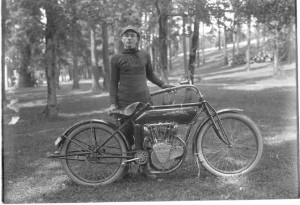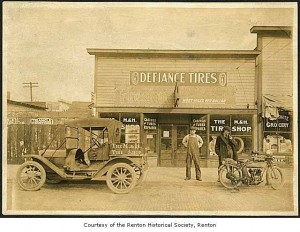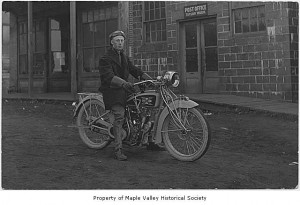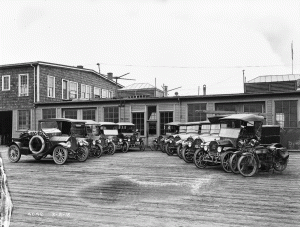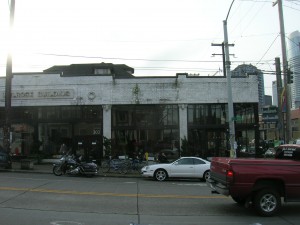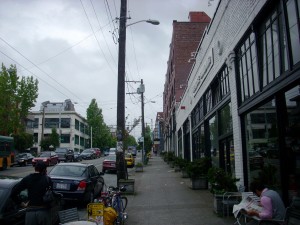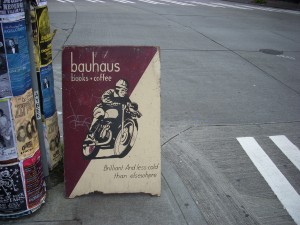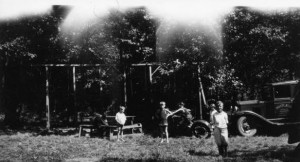This time we’ll continue to look at what it was like in Western Washington for motorcyclists in the days before the Jolly Rogers Motorcycle Club was founded in 1941.
My rationale is that the seeds were planted in the childhood of the founding members from what they saw around them in the local motorcycle scene during the teens, twenties and thirties. Besides, there are some fascinating old photos of the bikes people rode in those days that managed to survive all these many years later. These photos let us know that we are connected to a long and vibrant history of motorcycling here in the Pacific Northwest. We are riding the same streets and visiting the same sites as those who rode in the early days. For this blog I’m going to stick mostly to the teens.
While Harley-Davidsons and Indians ruled the roost in the 1940s when the J.R.M.C. was started, the photographic evidence shows more of other makes of motorcycles in the early days of Western Washington. Indian (so far) takes the prize for the oldest photograph of a bike in Western Washington – a 1907 photo of an early Indian with a forecar mounted to its forks, (forecars were used before sidecars were invented).
This same machine exists in a motorcycle museum in Chehalis which makes the photo all that much more interesting. After that it’s the 1910s photos of Excelsior and Flying Merkel that take center stage with a couple of 1910s Harley photos.
According to Herbert Wagner in his book on the first ten years of Harley-Davidson history, In The Beginning (well worth purchasing), the Merkel brand was well known in Milwaukee when the Harley Davidson was unknown. Additionally the styling of the 1903 Merkel is nearly identical with the first real Harley-Davidson except that the Harley motor was much bigger. Wagner thinks they got their styling cues from Merkel. As Harley-Davidson grew, Merkel shrank – the story of so many early motorcycle manufacturers. Then by the 1910s the Merkel factory was sold and a new company started under the name of Flying Merkel. This company had its factory in Pennsylvania. Somehow some Flying Merkels made it out here to Western Washington so there must have been a dealer somewhere in the area. I’ll keep my eyes out for where it might have been but for now I want to get this blog completed and posted so enjoy the photos. What is really neat is that one of them shows a Flying Merkel at the entrance to Mt. Rainier National Park which makes me think the dealer was probably in Tacoma; well built if it made it from there to the mountains on its own in those early years.
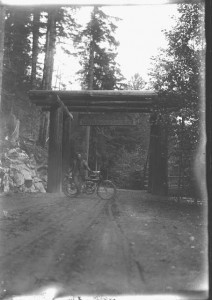
An early Flying Merkel at the entrance of Mt. Rainier National Park taken about 1908. Photo from Tacoma Public Library

As the remaining photos show, there seems to be a predominance of early Excelsior motorcycle photos. In the very first blog of the 1911 Endurance Run to Bellingham there is a line up of Excelsiors at Pioneer Square’s Pergola area. 1905/06 was the first year of production for Excelsiors and the photo from 1911 showing so many in one place makes me believe that there was an aggressive dealer marketing them. There may be other makes in that 1911 photo but all the bikes up close appear to be Excelsiors (see the December blog for this photo). Then there are several shots of businesses in Renton and Auburn and a post office at Taylor, WA with Excelsiors.
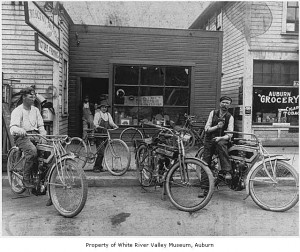
Crescent Bicycle Shop, Auburn, WA in 1912 showing a couple of Excelsiors and another antique motorcycle.
Considering that Excelsior was selling bikes to City government as well as individual riders, it must have had an enthusiastic following. One photo shows a rider proudly duded out in his Excelsior jersey and helmet. The photo has no other information with it but the fact that it was taken and shows the guy so proud in his “biker” outfit shows he was trying to impress the locals. Perhaps he was a racer and this was a publicity photo? Who knows?
So Excelsior is gone but it does have some lingering ghosts. Most noticeable, the famous Schwinn bicycle is still made today. And here in Seattle there is one particularly impressive ghost. You can still visit the old Seattle Excelsior dealership today. The current Bauhaus coffee shop on Pine Street in Capitol Hill is in the actual structure that originally housed the Hirsch motorcycle and bicycle shop. Hirsch sold Excelsior motorcycles from this location from about 1911 to 1930. They also had another dealership in Tacoma so I think that they were the dealer who sold all those Excelsiors. I think the Seattle dealership remained as a motorcycle shop after that but I’ll need to hit the main library and scope out the City Directories before I can confirm that. At first I thought that J.R.M.C. founding member Larry “Poke” Poitras used it but his Indian dealership was on 12th Ave in Capitol Hill. So between 1930 and 1990 I don’t know what the building was used for but by 1991 it became the coffee shop it is. The current proprietor of the coffee shop is proud enough of his heritage to use a motorcycle as the logo of his business (though it appears to be a pre-war BMW which makes sense since Bauhaus is an art and design phase of history originating in Germany in the 1920s and 30s) and he has a framed photo of Excelsior motorcycles in front of the building in the 1920s in the coffee shop by the cash register.
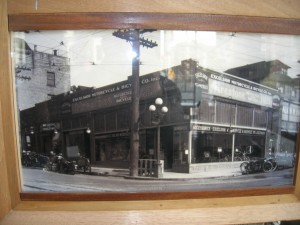
An undated picture (bikes appear to be 1920s era) inside the Bauhaus Coffee Shop on Pine Street showing the Excelsior motorcycle shop that the coffee shop now uses. (Photo by Bone)
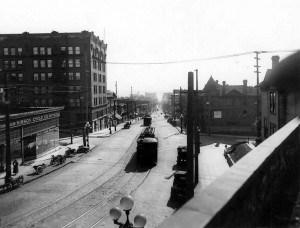
Asahel Curtis photo of the Excelsior Shop in 1917. Notice the solo and sidecar bikes on the sidewalk. The design of the building is different from the previous photos. This causes me to believe Hirsch upgraded the building between when this photo was taken and when the previous photo was taken in the 20s. (Photo UW Archives)
Besides the old photo the coffee shop has, I found another taken by pioneer photographer Asahel Curtis. Curtis is the guy the rest stop on I90 on the west side of Snoqualmie Pass is named after. He was an important early photographer of Seattle and environs from about 1900 to the 1930s. The photo I found that he took shows the building with several solo bikes, a sidecar laying on the sidewalk unconnected and a sidecar outfit all set up. A streetcar is passing the place. There is no other information but it is known that Curtis used to take photos of businesses for insurance reasons so that might be why he took that one. Like most postings in various archives, it is not catalogued under “motorcycle” or “bicycle” and only by lucky chance did I discover it. So it’s here for posterity.
The Excelsior name made a comeback in the late 1990s with the Excelsior-Henderson motorcycle – a new bike which heralded back to two famous old motorcycle names. I saw one once. All I remember of this “new” Excelsior was that the forks went through the fenders. Obviously they managed to make some prototypes but sadly the company died before mass production began. So Excelsior, for all intents and purposes, really is dead and gone but it did have an important presence in our area in the years before 1930.
Next time we’ll move into the twenties and the beginnings of Western Washington motorcycle clubs and from this to the birth of the Jolly Rogers Motorcycle Club.
Biker Bone January 21, 2009

